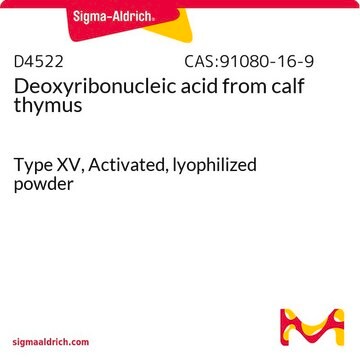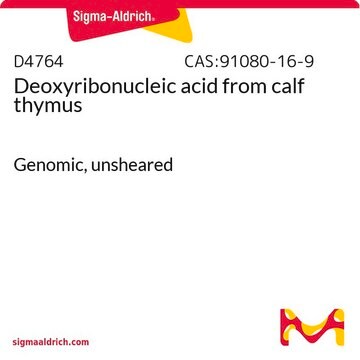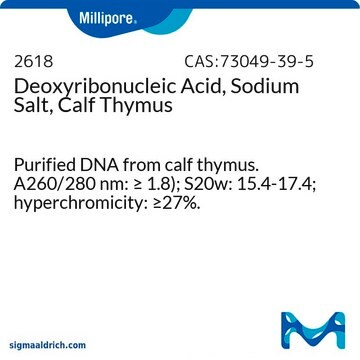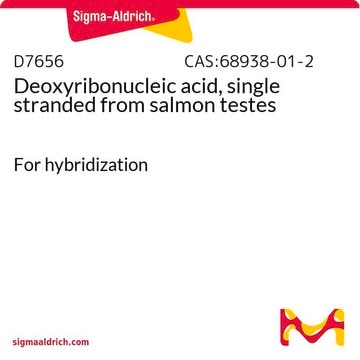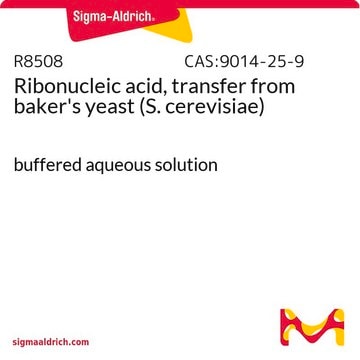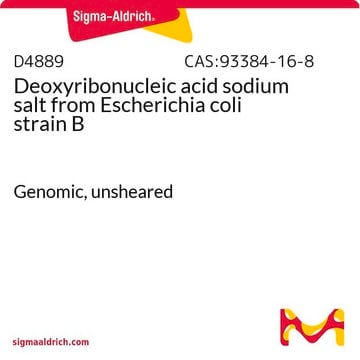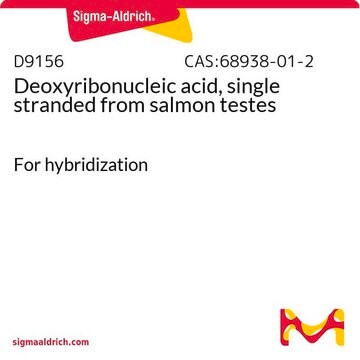D8661
Deoxyribonucleic acid solution from calf thymus
For hybridization
Anmeldenzur Ansicht organisationsspezifischer und vertraglich vereinbarter Preise
Alle Fotos(1)
About This Item
Empfohlene Produkte
Biologische Quelle
bovine thymus
Qualität
for molecular biology
Assay
9-11 mg/mL (DNA concentration)
Form
solution
Versandbedingung
dry ice
Lagertemp.
−20°C
Allgemeine Beschreibung
A ready-to-use solution of high quality double-stranded template DNA isolated from the thymus of male and female calves. The solution is supplied at a concentration of 9 - 12 mg/ml .
Anwendung
Deoxyribonucleic acid solution from calf thymus is suitable for use as a blocking agent in Southern hybridizations. It was used as negative control in DNA-DNA hybridization experiments using genomic DNA preparations of Vibrio parahaemolyticus and Vibrio alginolyticus. It was used as a standard for DNA quantification by fluorescent assay.
Many factors contribute to the signal-to-noise ratio in nucleic acid hybridizations. These factors include the presence of solvent (formamide), hybridization temperature, length of hybridization, volume of hybridization solution, degree and method of agitation, use of blocking reagents, concentration and specific activity of the probe, use of molecular agents to increase the rate of nucleic acid reassociation, and the degree of stringency used during the washing of the membrane.
In order to decrease any non-specific hybridization of the probe to a substrate, blocking agents must be used. Generally, a combination of blocking reagent, detergent, and denatured, fragmented DNA is used to accomplish this. Sigma offers sonicated, denatured DNA from a variety of species for use as a blocking agent in Northern and Southern blotting and other nucleic acid hybridization techniques.
In order to decrease any non-specific hybridization of the probe to a substrate, blocking agents must be used. Generally, a combination of blocking reagent, detergent, and denatured, fragmented DNA is used to accomplish this. Sigma offers sonicated, denatured DNA from a variety of species for use as a blocking agent in Northern and Southern blotting and other nucleic acid hybridization techniques.
Many factors contribute to the signal-to-noise ratio in nucleic acid hybridizations. These factors include the presence of solvent (formamide), hybridization temperature, length of hybridization, volume of hybridization solution, degree and method of agitation, use of blocking reagents, concentration and specific activity of the probe, use of molecular agents to increase the rate of nucleic acid reassociation, and the degree of stringency used during the washing of the membrane.
In order to decrease any non-specific hybridization of the probe to a substrate, blocking agents must be used. Generally, a combination of blocking reagent, detergent, and denatured, fragmented DNA is used to accomplish this. Sigma offers sonicated, denatured DNA from a variety of species for use as a blocking agent in Northern and Southern blotting and other nucleic acid hybridization techniques.
Deoxyribonucleic acid solution from calf thymus has been used in in situ hybridization and microarray hybridization.
In order to decrease any non-specific hybridization of the probe to a substrate, blocking agents must be used. Generally, a combination of blocking reagent, detergent, and denatured, fragmented DNA is used to accomplish this. Sigma offers sonicated, denatured DNA from a variety of species for use as a blocking agent in Northern and Southern blotting and other nucleic acid hybridization techniques.
Deoxyribonucleic acid solution from calf thymus has been used in in situ hybridization and microarray hybridization.
Angaben zur Herstellung
This DNA is phenol-chloroform extracted, ethanol precipitated, and sonicated to produce single-stranded fragments which comigrate with the 587 and 831 base pair marker fragments.
Sonstige Hinweise
DNA in solution will reanneal on standing at room temperature so it is recommended to boil the solution for 10 minutes and then cool on ice for at least 5 minutes prior to use.
Ähnliches Produkt
Produkt-Nr.
Beschreibung
Preisangaben
Lagerklassenschlüssel
12 - Non Combustible Liquids
WGK
WGK 2
Flammpunkt (°F)
Not applicable
Flammpunkt (°C)
Not applicable
Persönliche Schutzausrüstung
Eyeshields, Gloves, type N95 (US)
Analysenzertifikate (COA)
Suchen Sie nach Analysenzertifikate (COA), indem Sie die Lot-/Chargennummer des Produkts eingeben. Lot- und Chargennummern sind auf dem Produktetikett hinter den Wörtern ‘Lot’ oder ‘Batch’ (Lot oder Charge) zu finden.
Besitzen Sie dieses Produkt bereits?
In der Dokumentenbibliothek finden Sie die Dokumentation zu den Produkten, die Sie kürzlich erworben haben.
Kunden haben sich ebenfalls angesehen
Annick Robert-Pillot et al.
FEMS microbiology letters, 215(1), 1-6 (2002-10-24)
We compared the efficiencies of biochemical methods and polymerase chain reaction (PCR) for the identification of Vibrio parahaemolyticus strains. The 122 isolates studied, identified by biochemical tests as V. parahaemolyticus or Vibrio alginolyticus, were tested by R72H PCR assay. The
C Booth et al.
Nucleic acids research, 29(21), 4414-4422 (2001-11-03)
We have developed a method that allows quantitative amplification of single-stranded DNA (QAOS) in a sample that is primarily double-stranded DNA (dsDNA). Single-stranded DNA (ssDNA) is first captured by annealing a tagging primer at low temperature. Primer extension follows to
William D Hardie et al.
American journal of respiratory cell and molecular biology, 37(3), 309-321 (2007-05-15)
Expression of transforming growth factor alpha (TGF-alpha) in the respiratory epithelium of transgenic mice caused pulmonary fibrosis, cachexia, pulmonary hypertension, and altered lung function. To identify genes and molecular pathways mediating lung remodeling, mRNA microarray analysis was performed at multiple
Lawrence E Heisler et al.
Nucleic acids research, 33(9), 2952-2961 (2005-05-25)
An effective tool for the global analysis of both DNA methylation status and protein-chromatin interactions is a microarray constructed with sequences containing regulatory elements. One type of array suited for this purpose takes advantage of the strong association between CpG
Frequency of aneuploidy in in vitro-matured MII oocytes and corresponding first polar bodies in two dairy cattle (Bos taurus) breeds as determined by dual-color fluorescent in situ hybridization
Nicodemo D, et al.
Theriogenology, 73(4), 523-529 (2010)
Unser Team von Wissenschaftlern verfügt über Erfahrung in allen Forschungsbereichen einschließlich Life Science, Materialwissenschaften, chemischer Synthese, Chromatographie, Analytik und vielen mehr..
Setzen Sie sich mit dem technischen Dienst in Verbindung.